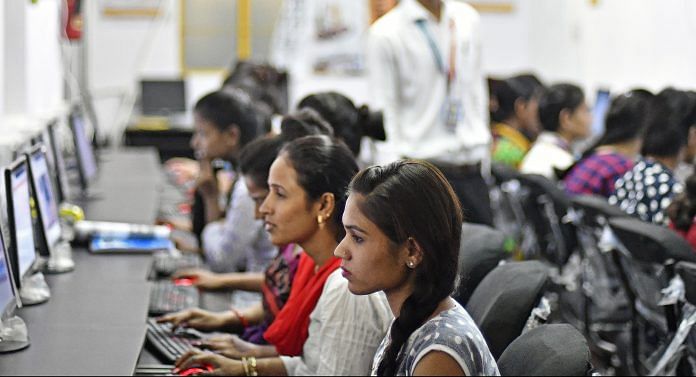Tejashwi Yadav latest declaration stands out among all the populist promises being made in the run-up to the Bihar Assembly elections—every household in one of India’s poorest states, with over 100 million people, will have a government job.
It isn’t just Bihar. Across India, for too many people, a government job remains the gold standard of aspiration. And that is because the challenge of getting a well-paid job is a real one. For an economy that is projected to become the third largest in the world before the end of this decade, this is a most unusual conundrum. Trends from the world’s two largest economies reveal the gap between them and India, but they also offer a clear pathway to accelerate growth and create well-paid jobs.
Consider two recent sets of data from the US and China. First, it is estimated that 40 per cent of the share of US GDP growth this year will be driven by the hundreds of billions of dollars being invested in AI. A related data point is that 80 per cent of the growth in US stock markets this year is because of AI-related stocks alone. Second, in the first seven months of the year, China’s “energy” exports outpaced the US. China exported around $120 billion worth of green technology, whereas the US exported $80 billion worth of fossil fuels. AI and green tech are the two defining drivers of technological change in the world, and the number 1 and number 2 economies of the world are chasing the big prizes.
Gap left by US, China
And it isn’t a matter of either-or. While the Trump government has put many green incentives in cold storage, there is still a strong “green play” in the US. There is Tesla, of course, a (perhaps no longer “the”) leading maker of electric vehicles. And there is the continued quest for critical minerals, including rare earths, which underpin energy transition technologies far more than they do AI (except copper). Similarly, China is very much in the AI race (think DeepSeek), and the Hong Kong stock markets are doing very well, partly due to companies in the AI space. Perhaps it’s unsurprising that China is now the global leader in green tech, closely linked to its strength in manufacturing, while the US leads in AI, reflecting its strength in tech.
What is India’s strength? Labour, still cheap by global standards. As the US and China race ahead on the technological frontier, they are leaving behind a vacant space in traditional, labour-intensive manufacturing – garments, footwear, toys, sports goods, etc. US President Donald Trump’s tariffs are not going to bring every kind of manufacturing back to the US. China’s higher wages will no longer allow it to be the most competitive in labour-intensive, mass-produced goods. India just cannot afford to miss this bus, even while it can afford to play catch-up in AI and green tech.
Artificial Intelligence, in particular, will reduce jobs at the lower end of the skill spectrum, which is where a majority of India’s workforce sits. Labour-intensive manufacturing is the only route for this section of the workforce to gainful employment.
Also read: India needs a National Jobs Mission, not just skilling
One last chance
The window is getting smaller to implement reforms required to give this sector a real fillip. From India’s point of view, there is a real risk that Vietnam will be the big winner in the space left open by the US and China. Its per capita income is already 60-70 per cent higher than India’s. The reforms required in India are well known – in land, labour, clearances, power tariffs, and rail freight rates. All of them need the government to take a step back and allow free enterprise to flourish at scale.
Needless to say, India will also invest in AI and will develop green tech, but these need not consume the government’s time and effort. These should be left, mostly unregulated, for the private sector to pursue. India’s most notable, and perhaps only, truly global success story is the country’s IT sector, which grew in the absence of the government’s visible hand. Too much of the government’s attention on frontier technologies will likely lead to over-regulation and a stifling of innovation. That is what India’s history tells us.
The government’s entire bandwidth and political capital should be invested in giving traditional manufacturing one last chance to fly.
Otherwise, it may become increasingly difficult to get out of the trap of being an economy that creates an insufficient amount of good, well-paid jobs for its entire workforce. A government job cannot be the future. Indeed, it was never sufficient for prosperity in the past.
The author is Chief Economist, Vedanta. He tweets @nayyardhiraj. Views are personal.
(Edited by Ratan Priya)







Yadav’s promise is absurd. It’s simply not possible. We’d also have to think about employability of folks. Was in a premier institution to hire recently (its among top 20 in its domain as per recent NIRF) but the quality of students was extremely disappointing. Unprepared and unprofessional would describe 50% of those whom we interviewed. How imagine the employability of others who go to regular places or perhaps don’t even have required education/skills.
Absurd promises and reservation levels will further kill competitiveness of Indian workers. Perhaps that’s what this INDI camp wants.